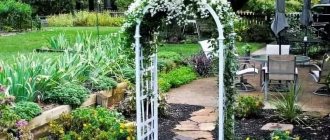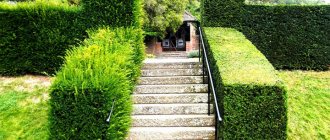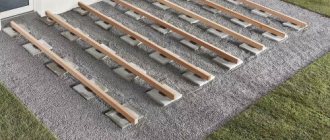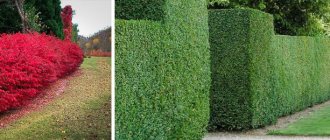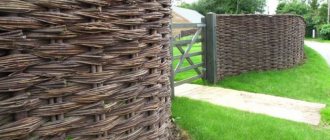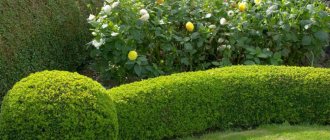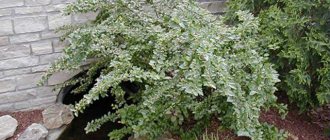In landscape design, willow hedges are often used to decorate the perimeter of a site. These plastic, fast-growing plants can be woven and shaped. An elegant fence can become an aesthetic zoning element. With proper care, plants look beautiful and create openwork shade.
A willow hedge is one of the oldest ways to mark the boundaries of your territory.
Using willow in landscape design
A living wicker fence made of willow is also formed in the form of tunnels, wickerwork, a series of light columns reminiscent of a carved palm tree, or a sparse hedge of single bushes.
Young willow branches can be intertwined, depicting beautiful patterns and designs
Various manipulations are carried out with flexible willow branches; young shoots can easily be woven together in any sequence. In a couple of years, when the trunks become woody, it’s nice to admire the creation of your own hands.
Intertwined willow branches form a fairly strong wall that protects the area from the penetration of people and animals
Unusual solutions in the form of wicker fences always become a bright accent. They look exotic in the landscape of homesteads.
To prevent the wattles from becoming overgrown, young shoots are removed several times a season, preventing side shoots from forming. The tops of the hedges are formed with pruning shears.
Live fence
Planting material for hedges can be obtained free of charge if a suitable variety of willow grows in your area
Before planting plants, you need to decide on the shape of the weaving. The fence is formed in various ways:
- In one rod with a certain step, willows are planted at a distance of 10–20 cm. The disadvantage of this form is the violation of the pattern after an unsuccessful wintering, when one or more plants die. A new seedling will have to be planted, but it will not soon catch up with its neighbors in thickness.
The cuttings are planted in well-moistened soil, leaving at least 2–3 growth buds on the surface - Weaving with two or three vines is more reliable and eliminates design defects. When planting, 2 or 3 seedlings are placed in one hole at a time at a short distance from each other.
- The cross pattern is similar to the usual 1-vine weaving, only in addition to the plants crossing diagonally, the plantings are supplemented with upright growing willows and a twill weaving is formed. Straight plants will bear the main load and will support the living fence in a vertical position.
Weaving in one vine
Three vine weaving
Cross weave
Tunnel arch made of willow
Arched structures are created from various varieties of willow, with the exception of tall white willow and brittle willow. Beautiful living tunnels are made from willow (common willow), black willow, and varieties with red and purple leaves.
Every gardener can grow such a tunnel.
Small instructions:
- plants are planted in even rows at a distance of 80 to 1.5 m;
- at a height of 2–3 meters, the shoots are connected to each other by tying them with fishing line;
- To speed up the process of merging at the points of contact, the bark is cut off, the crossing points are wrapped in polyethylene, then it is removed.
It is better to cover the surface of the earth with black non-woven material until the rods take root.
Such tunnels replace gazebos and are used in the east for the tea ceremony. During formative pruning, the outer and inner parts of the living structure are cut.
The trunks are allowed to grow over their entire height, the tops are directed downward so that there are no voids in the root area.
Landing
When creating a hedge, knowledge of certain nuances requires planting willow.
Procurement of material
- The material is prepared in the fall after leaf fall or in March before the buds awaken.
- Cut healthy young shoots approximately 30 cm long from an adult tree. Make a 2-centimeter cut at the bottom for better root germination. Place in a jar of rooting agent solution for a couple of hours.
- In the spring, dig into the greenhouse, leaving 2-3 buds above the surface. In the fall, plant in boxes with fertile soil, cover with polyethylene and place in the basement.
- Water regularly and abundantly.
- Before planting, sort out diseased and damaged twigs.
- In autumn (before frost) or spring (after warming) plant in open ground according to a pre-selected scheme.
On a note. Buying willow for hedges is not economically profitable: a lot of material is required. If you still choose this option, pay attention to the quality of the seedlings: they must be without damage and must have a lump of earth.
Preparing the site
- Willow prefers acidic soil.
- The place should be illuminated by the sun for at least 5 hours a day. Full shade will not work.
- Along the lines along which you plan to plant the willow hedge, drive in pegs, pull the thread (string/rope), and apply markings according to the chosen pattern.
- Dig a trench along the marking: the depth and width are approximately the same ≈ 0.5 m.
- Apply fertilizer.
- Drive in pegs or build a frame for support.
Planting cuttings
- Maintain an interval between plantings of ≈ 20 cm.
- For a diamond-shaped wicker hedge, immediately plant the cuttings at an angle of ≈ 45° to the ground surface.
- Sprinkle with pre-prepared soil mixture. This can be fertile soil enriched with compost organic matter, peat and manure.
- Tie the joining places of the cuttings with clamps.
- Water generously.
To create an arched tunnel, mature, fairly long plants are chosen. They are planted at intervals of ≈ 80 cm. At a height of about 2 m, the vines standing opposite each other are connected with a clamp. At the points of contact, cut off the bark and wrap it in polyethylene (can be removed after a month).
If you plant a willow, following these recommendations, the hedge will turn out not only beautiful, but also functional - it will successfully perform all the tasks that were originally assigned to it (sound insulation, zoning, etc.).
Willow varieties for a living fence
In the world there are more than 500 species of willow, broom, willow, vine, willow, shelyuga - willow has many names. Willow for hedges is selected according to external characteristics and species characteristics. The stem should be dense and flexible and not break during formation. No more than 20 varieties are popular. The most decorative ones require a detailed description.
A living willow wall can grow in three years
Willow Purple Nana
This is a shrub variety 4 meters high with grayish-blue leaves and purple catkins. The bush blooms in June and is a honey plant.
Purple willow is often used in suburban areas as an ornamental shrub.
Weeping willow (Babylonian)
A decorative type of tree broom that easily adapts to any conditions, grows up to 12 m, and is used for tunnel planting. Earrings are yellowish with a gray tint. The variety is heat-loving and grows well in the Crimea, the Caucasus, and the Far East.
Weeping willow in natural conditions grows mainly near bodies of water
Willow Purple Pendula
A low-growing variety, reaches a height of 2 meters, is unpretentious, and is characterized by rapid growth. The bush produces purple catkins in June, grows on any soil, and is frost-resistant.
The height of this willow variety depends on the grafting
Willow willow (yellow willow, pomerania)
A woody type of plant, in Europe it reaches 12 m, in Russia - 6 m. It blooms in April or early May, depending on the climate. It features decorative foliage with a bluish tint. In a year it grows up to 50 cm.
Wolf willow is widespread in the European part of Russia.
Willow Ural Twisty
Woody species up to 3.5 m high, quickly grows foliage, drought-resistant variety, not susceptible to scab.
A variety with very twisting branches, giving the plant a special decorative effect.
Iwa Hakuro Nishiki
The main difference of the variety is the variegated color of the leaves, numerous inclusions are randomly scattered across beige, cream or pale pink leaf plates. The plant is not afraid of frost and grows well in flooded areas.
Japanese willow Hakuro Nishiki is completely different from its wild relatives
Varieties of flower beds
There are two different types of wicker flower beds. Each one is good in its own way! A small-sized ground woven flower bed can be easily moved from one place to another, which allows you to change the design of the site. A hanging wicker flowerbed will stylishly enliven the wall of a country house or garden. When weaving a hanging structure, the subtleties of its creation are taken into account:
- The mount must rotate freely around its axis. This is necessary so that the flowerbed can be rotated periodically to ensure even sunlight on the flowers.
- For planting in hanging flower beds, decorative plants or flowers that do not require strict care are used. An excellent option would be pansies, petunias, and daisies. These flowers grow quite quickly, and soon the flowerbed will become a hanging garden.
- Many varieties of flowers have a developed root system, so a wicker flower bed should have an internal volume of at least 10 liters. Otherwise, the roots will begin to displace the soil, and this will lead to the death of the flowers.
- When planting plants in suspended structures, you need to ensure that the soil is always slightly moist. Mineral elements are washed out of the soil mixture when watering, so you need to feed flowering plants in a timely manner.
The above-ground wicker flower bed is used most often. When the diameter of the flower bed is significant, it is built in the form of a fence with elegant weaving.
If you weave an additional canopy in the flowerbed, it will serve as a support for climbing flowering plants. To arrange it, you need to dig six more long (about one and a half meters) rods into the ground at the edge of the flower bed. Two rods are intertwined. The remaining four rods are used to form a lattice into which the growing shoots will then be woven.
Recommendations for caring for a living willow fence
With proper agricultural technology, willow in a hedge gives a good annual growth of 15 to 25 cm, depending on the variety. Constant care consists of regular watering, weeding, and loosening.
Willows are moisture-loving; young plantings especially need watering. In dry weather, annual and biennial hedges are watered up to 2 times a week. Mature plantings with long roots are able to extract moisture from deep layers, so they do not need frequent watering.
Young willow seedlings especially need care in the first years after planting
They loosen and weed the plantings at a distance of up to 50 cm on both sides of the fence. Fertilizing is applied no more than once every three years. Fertile, loose soil is enriched with minerals only when the willow leaves begin to shrink.
Any fertilizer intended for decorative deciduous plants is suitable for feeding willow.
Spring spraying with fungicides along the green cone is recommended (when the buds open). Fumigation of tobacco crumbs is effective against aphids. Young heat-loving plants are covered for the winter in the first years: huts are built from branches and dry grass at the root part.
Selection and procurement of seedlings
To make the hedge beautiful, you need to select or prepare planting material correctly.
Willow cuttings need to be harvested during formative pruning. The optimal thickness of the branches for harvesting is from 5 mm, the length of the future seedling is 40-45 cm. The prepared rod must be buried more than half into the soil, having first made an oblique cut. As a result, a powerful root system is formed.
Planting material can be stored in trenches, pits, and cellars. You can also purchase ready-made seedlings. Before purchasing, you should carefully examine the cutting itself and its root system. It is better to buy seedlings from agricultural companies or specialized nurseries. This way there is a guarantee that these are good cuttings. You may find spoiled or diseased specimens on the market that will not take root or develop.
Formation of willow fences - pruning, tying, weaving
Weaving of shoots begins in the first year of growth. In the fall, the plantings are inspected, weak and damaged plants are replaced with new ones, the first crosses are made, and the stems are secured with fishing line.
The process of creating a willow hedge consists of 3 stages: planting, shaping and pruning
Willow hedges are trimmed at least twice a year:
- In the spring, sanitary pruning is carried out, frozen, dried branches and shoots extending beyond the fence profile are removed.
- Plants continue to form in the fall and throughout the summer.
Free-growing hedges are renewed by shortening the shoots by ¾ of the length; a medium is made above the outer bud. In standard forms, the root shoots and growing rootstock are removed every spring and autumn.
Strengthening the rods
If the rods are thin, then when weaving, you can put several of them together. Excess ends can be easily removed with pruning shears. In this case, the hedge itself will not be brittle. But usually varieties intended for hedges are not brittle.
Freshly cut rods for weaving must be immersed in boiling water for 5 minutes and rinsed. This will help avoid fungal plaque and increase their shelf life.
Photo examples of beautiful willow decorations
The grace of living willow fences is created by many years of work. Tunnel plantings are a “feature” of sites in the southern regions. In a green structure it is always cool and fresh, it is easy to breathe, because the bushes produce oxygen.
It is easy to give willow the desired shape, most suitable for the style of a country plot
A wicker fence helps create unique compositions. The frame can be made of any shape and height. Even rows of colored willow varieties will decorate the central alley, and winding garden paths will turn into fairy-tale decorations.
Living willow fence between neighboring plots
Living willow wall along garden path
Combination of a hedge with an arch on a path
Arches are considered a popular form of creating hedges. Banal welded frames made of galvanized or stainless steel rods are transformed into living tunnels and small arched gazebos.
You can create very unusual and original designs from willow
Zoning the garden with oval hedges looks beautiful. Labyrinths and green wickerwork are made from willow. A willow fence, with all its brevity and external fragility, becomes a reliable protection against street dust, noise, and prying eyes. Willow is present in many landscape projects of leading designers.
Design options for wicker fences
A similar weaving technique is called openwork by artisans. Growing a hedge is not easy a priori; creating an openwork weave is doubly difficult. Therefore, this area of work is often performed by professional gardeners. There are several options for weaving design.
- Hedges are fundamental structures intertwined with young vine shoots. There are many options for weaving: braid, zigzag, ladder.
Braiding
This aspect directly characterizes the quality of the material, how plastic and moldable the shoots are. Young growth is much more pliable, so it is recommended to braid a freshly grown vine. Global plantings can be combined with an installed fence, covering the simplicity of the design, giving a green, fresh, unusual look.
- Much more often, this type of fencing performs a purely decorative function. Often, small wicker plantings enclose patios and zone the space of a personal plot. Such functionality requires more detailed development. Wicker branches located near the walls of the fence will stand steadily, having reliable support. Zoning fences also need to provide additional support by driving in retaining pegs.
It is important to note that a regular wicker fence and a wicker fence are different concepts. Wickerwork is made from special cuttings of vines and soft wood; wicker fencing is made from directly growing trees collected in one braided bush.
